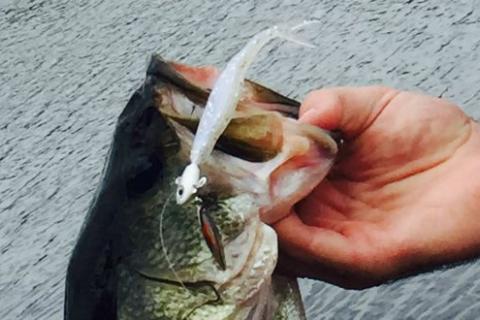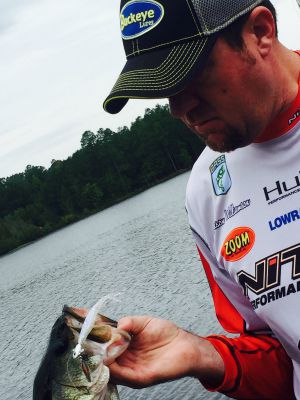
They had to delay the start of the 2015 Bassmaster Classic due to icy roads and boats stuck to their trailer bunks. There were single digit temperatures in South Carolina when the competitors finally blasted off – or gradually floated off, as the case may be – into Lake Hartwell.
When three days of grueling competition came to an end, local favorite Casey Ashley emerged victorious. His primary tool? An underspin paired with a Zoom Super Fluke Jr. The “under” in underspin could relate to two characterizations: UNDERused and midUNDERstood.
Don’t be one of the anglers who fail to recognize their situational power.
Not Just for Winter

As a general rule, these otherwise nondescript jigheads are distinguished only by the protruding blades that emerge from beneath their chins. They’re not sexy, not exciting—and they’re not just for winter.
Think back a decade ago, and you may recall that Aaron Martens finished 2nd in another South Carolina Classic—the 2004 rodeo at Lake Wylie—by catching suspended fish around bridge pilings. Many of them were caught on his “horsey head,” a homemade version of a popular underspin with upgraded components.
It’s not the temperature or season that links these catches, but rather the bait and the state,—so we turned to Nitro pro Jason Williamson of South Carolina to tell us how to fish these lures when it’s warm.
JWill’s Wise Words
Despite the Classic-based promotion of underspins, they’re still not very popular in winteror summer. When dropping on deep bass, most anglers are more likely to grab a jigging spoon, a dropshot, or a big hairy mop jig to get the job done. None have the same combination of subtlety, erratic action and flash of this simple killer.
“Where I’ve had the most success with underspins in warm weather is around standing timber,” Williamson said. “Also around bridge pilings and manmade cane pilings.”
He makes long casts past the cover so the bait can sink slowly and intersect the top of it.
“What I try to do is count it down,” he said. “I try to let the bait sink slowly and get to the top of the timber. Not necessarily touching it, but really close. Then I’ll reel it back.” In the case of nomadic schools of suspended bass, Williamson is just as likely to count down the underspin to where he sees the fish or their prey on his graph. Unlike the wintertime crawl employed by Ashley, it pays to add a bit of razzle-dazzle during the summer. With a pumping, jerking, twitching or otherwise erratic action in their midst, the underspin can yield jarring hits. It’s good not just on largemouths, but spotted bass and smallmouths as well.
He prefers a 7’ medium-heavy Duckett Micro-Magic baitcasting rod for this technique, noting that “long casts are really important.” He pairs it with a 6.3:1 gear ratio reel spooled with 10 or 12 pound test Gamma Fluorocarbon, which is perfect for slow rolling.
The Bait
Williamson’s favorite underspin is the Buckeye Su-Spin, which features double willowleaf blades on a dog leg arm protruding from beneath the head.
“Those two blades keep it higher in the water column, so you can get away with a heavier bait on the back of it,” he explained. “This is a technique that works best in clear water, and the heavier bait allows you to make longer casts and cover more water.”
Like Ashley, he most often pairs it with the Zoom Super Fluke Jr. in some form of shad imitating color – typically white or albino. This is another area where experimentation is key. Different head sizes and soft plastics paired together create different fall rates and different actions.
Be sure to super-glue your soft plastic to the head to keep it in place and to save money. If you’re around spots or smallmouths, a quick dip in chartreuse dipping dye can elicit extra strikes.
Just remember that these simple lures aren’t only for winter. They’re not necessarily the most snag-resistant bait in your boat, but they work anywhere bass feed on baitfish. They can also be fished from 2 feet deep down to 50 or 60, and that makes them a tool you shouldn’t underestimate.
- 17243 views

